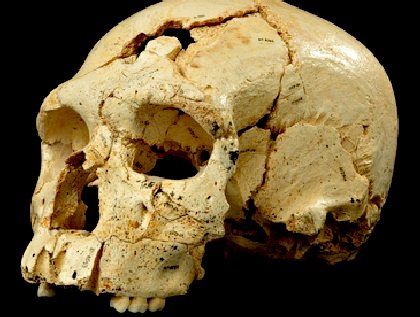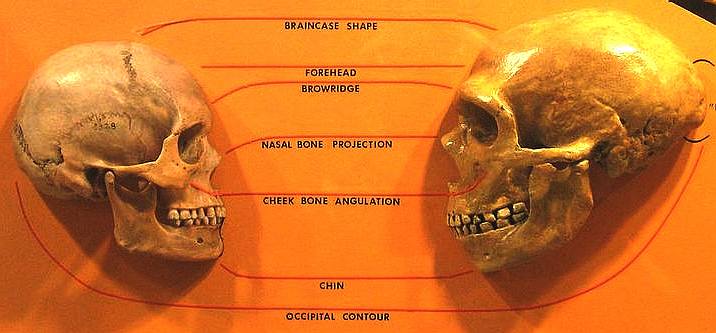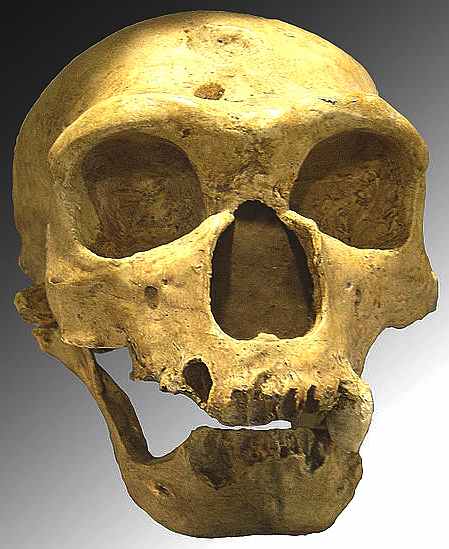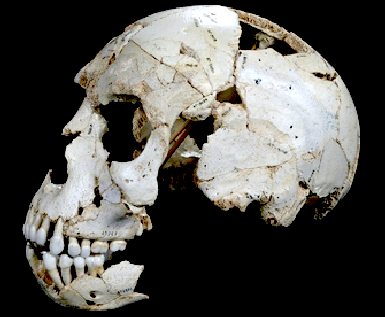|

A primitive Neanderthal skull from the Sima de los Huesos cave in Sierra de
Atapuerca, Spain.
JUNE
2014, MADRID, SPAIN
Ancient skulls recovered from a deep cave in northern Spain are the oldest known remains to show clear signs of Neanderthal facial features, researchers claim.
Scientists reconstructed 17 skulls from pieces of bone found in the mud at Sima de los Huesos, or the "Pit of Bones", in the Atapuerca mountains. The skulls had some Neanderthal-like features, but their appearance was otherwise far more primitive.
Juan Luis Arsuaga, professor of palaeontology at the Complutense University of Madrid, said the remains belonged to a "missing link" population that fell somewhere between the Neanderthals and a more archaic group of human forerunners.
The term "missing link" has fallen out of favour with many researchers, in part because it implies a simple, step-wise progression from one species to another. But the phrase is still used at times to describe species that bridge a divide between distinct ancestors and descendants.
The skulls come from a haul of bones that belong to at least 28 individuals who came to rest in a chamber at the bottom of a 14-metre-deep cave shaft. The bodies are thought to have been washed into the pit after they died elsewhere in the cave system.
Measurements of the bones, which are around 430,000 years old, suggest that trademark features of Neanderthals did not emerge at the same rate, but that some evolved much earlier than others.
The skulls at Sima de los Huesos have Neanderthal-like teeth and jaw structures, and other similarities in the brow ridges and nasal apertures, or channels. But their braincases are small, unlike the elongated crania of the big-brained Neanderthals. Of the 17 skulls reported in Science, seven have not been studied before.
The Sima population, as they are known, probably developed Neanderthal-like jaws and teeth from chewing and the heavy use of their front teeth and incisors for other tasks. "We think it's related to the use of their mouths as a 'third hand', or as part of their behaviour to grasp and to pull things with the front teeth," Arsuaga told the
Guardian.
"We can't say they are the direct ancestors of Neanderthals. All we can say is that the population are members of the Neanderthal lineage. They are a 'missing link' between the Neanderthals and a population that was much more primitive," he added.
The Spanish team believe the more primitive population could be an ancient human species called Homo antecessor, which lived in Europe around one million years ago. "They could be the stem group before the split between Neanderthals and modern humans," Arsuaga said.
Neanderthals emerged around 400,000 years ago, and lived in Europe and Asia until around 35,000 years ago. They were replaced – though not before some interbreeding – by modern humans that evolved in
Africa and colonised Eurasia 50,000 years ago.
In previous reports, the Spanish researchers had claimed the Sima de los Huesos remains were much older, around 600,000 years old, and that they belonged to an ancient group called Homo heidelbergensis. The latest study changes both of those interpretations.
"They now agree that the fossils belong to the Neanderthal lineage but not to the species Homo heidelbergensis. And they have revised the dating of the fossils to about 430,000 years, giving much more substantial agreement between our views," said Chris Stringer, head of human origins at the Natural History Museum in London.
"The rich Sima de los Huesos material, with every part of the skeleton beautifully preserved, will continue to inform us about human evolution 400,000 years ago as research continues on this astonishing, and even beautiful, collection of human fossils," Stringer said.

Comparison
of Homo Sapiens and Neanderthal skulls
For
me, the most important recent stages of human evolution bounce through
the Australopithecines, Homo Habilis, Homo Erectus with some deviation,
such as Homo Heidelbergensis and Homo Neanderthalis, to Homo Sapiens.
Following such a trail there is a regular increase in brain capacity - a
reliable indicator of advancement. That's my thinking, but I'm no
expert. The skull is to my mind the best indicator of development, that
is if I had to choose. But, obviously I'd prefer to see the whole
story.
Australopithecus
Australopithcus
africanus
Kenyanthropus
Paranthropus
robustus
Homo
habilis
Homo
erectus
Homo
heidelbergensis
Homo
neanderthalensis
Homo
Sapiens Sapiens
Homo
Sapiens Superior (Kanis
Rex)

Skull
of homo sapiens neanderthalensis
LINKS:
Webpage
"History of German Anthropology/Ethnology 1945/49-1990
American
Anthropological Association Homepage largest pro org of
anthropologists
European
Association of Social Anthropologists
American
Association of Physical Anthropologists
Australian
Anthropological Society
Iberoamerican
Association of Anthropology AIBR
European
Association of Social Anthropologists
Moving
Anthropology Student Network - International Association
Italian
Institute of Anthropology
National
Association for the Practice of Anthropology
The
Royal Anthropological Institute Homepage of Great Britain and
Ireland (RAI)
The
Society for Applied Anthropology
Annual
Review of Anthropology
Division
of Anthropology, American Museum of Natural History Online
database
National
Anthropological Archives, Smithsonian Institution
The
Anthropological Index Online Online biblographic database.
Anthropology
Researcher and Groups
http://www.theguardian.com/science/2014/jun/19/neanderthal-faces-spanish-cave?CMP=EMCNEWEML6619I2 http://www.theguardian.com/science/2014/jun/19/neanderthal-faces-spanish-cave?CMP=EMCNEWEML6619I2
HUMANS:

The population represented by the bones in the cave probably developed
Neanderthal like jaws and teeth from chewing and the heavy use of their front teeth and incisors for other tasks. Anthropology
| Archaeology | Dinosaurs
| Evolution | Fossils
| Geology | Mammoths
Meteorites | Paleontology
| Plate Tectonics | Neanderthal
Man

Evolution
accelerated by man
an
anthropological anthem by
Jameson
Hunter
OTHER
ANIMALS:
|
AMPHIBIANS |
Such
as frogs (class: Amphibia) |
|
ANNELIDS |
As
in Earthworms (phyla: Annelida) |
|
ANTHROPOLOGY |
Neanderthals,
Homo Erectus (Extinct) |
|
ARACHNIDS |
Spiders
(class: Arachnida) |
|
ARTHROPODS |
Crabs,
spiders, insects (phyla: Arthropoda) |
|
BIRDS
|
Such
as Eagles, Albatross
(class: Aves) |
|
CETACEANS
|
such
as Whales
& Dolphins
( order:Cetacea) |
|
CRUSTACEANS |
such
as crabs (subphyla: Crustacea) |
|
DINOSAURS
|
Tyranosaurus
Rex, Brontosaurus (Extinct) |
|
ECHINODERMS |
As
in Starfish (phyla: Echinodermata) |
|
FISH
|
Sharks,
Tuna (group: Pisces) |
|
HUMANS
- MAN |
Homo
Sapiens THE
BRAIN |
|
INSECTS |
Ants,
(subphyla: Uniramia class:
Insecta) |
|
LIFE
ON EARTH
|
Which
includes PLANTS
non- animal life |
|
MAMMALS
|
Warm
blooded animals (class: Mammalia) |
|
MARSUPIALS |
Such
as Kangaroos
(order: Marsupialia) |
|
MOLLUSKS |
Such
as octopus (phyla: Mollusca) |
|
PLANTS |
Trees
- |
|
PRIMATES |
Gorillas,
Chimpanzees
(order: Primates) |
|
REPTILES |
As
in Crocodiles,
Snakes (class: Reptilia) |
|
RODENTS |
such
as Rats, Mice (order: Rodentia) |
|
SIMPLE
LIFE FORMS
|
As
in Amoeba, plankton (phyla: protozoa) |
|
|
|



